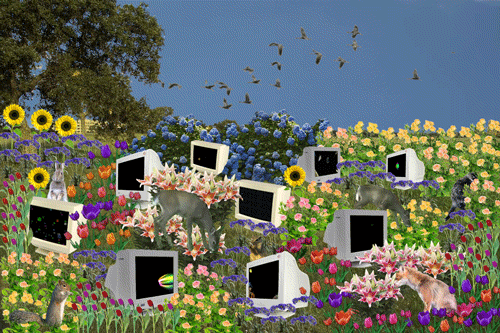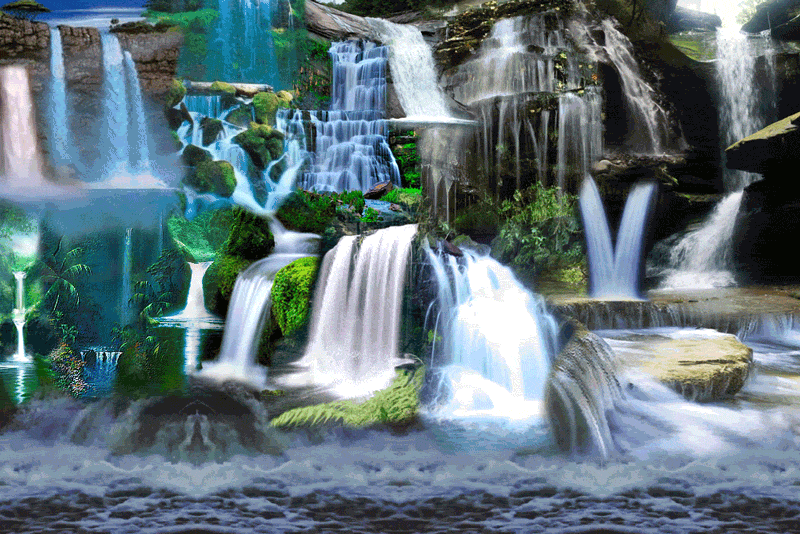Faith Holland and Chatrooms III: Click, Click, Click
New York-based multimedia artist, Faith Holland, has been chatting with me about Chatrooms III: Click, Click, Click, the survey of contemporary digital moving image practices—GIFs, augmented performances, green screen keying, collage, appropriation, Processing and 3D renders— she and Nora O’ Murchu curated. Chatrooms is a series of one-night-only digital art screenings, installations, and conversations organized by Morehshin Allahyari and Willa Köerner from Gray Area Art and Technology’s Cultural Incubator in San Francisco. It will be screening and streaming Thursday, January 15 at 7:00 pm. Faith’s own solo show, Technophilia, will open at Transfer Gallery in Brooklyn this June.
Dafna Ganani, I Dream of I Dream of Jennie, 2013, 3:42 min.
Liz Sales: Where are you living these days?
Faith Holland: Providence and New York. We’ll be in New York full-time in June. My partner is at Brown.
LS: Your upcoming exhibition, Chatrooms III: Click, Click, Click, is not in NY?
FH: It’s been traveling. It showed in New York in August. It was originally a companion to Coded after Lovelace, an exhibition Nora and I curated as well. This screening is part of a curated series that Morehshin Allahyari and Willa Koerner are doing at Gray Area, in San Francisco.
LS: What is Chatrooms?
FH: Chatrooms is the name of Gray Area’s series. This is their third event; other events have been screenings of Lorna Mills’ Ways of Something and GIFbites. They have a really great Tumblr.
LS: What was your and Nora’s curatorial strategy?
FH: We were putting together Coded after Lovelace as an intergenerational show of women artists working with technology. We found there were a lot of other artists we wanted to include but couldn’t due to budget and time constraints, so we put together this screening to focus on contemporary digital video practice. I really wanted to highlight a variety of approaches.
LS: Are their particular challenges for female digital video artists? Or advantages?
FH: On the production end, they’re not particular at all. But exhibition after exhibition includes a disproportionate number of men. Our program itself does not have anything to do with being a woman. It doesn’t NEED to be explained through the lens of gender; this is a screening of strong, contemporary digital works.
Honestly, our original press releases left out the word “women” even though we very strictly curating that way.
LS: Fair enough. Is this solely a seated screening or are there additional ways to view the work?
FH: It’s a seated screening. You sit and watch. I like to show this work in this way because it forces you to pay attention to and think about these disparate pieces in relation to each other.
LS: I think I’d enjoy sitting in a quiet room and watching a GIF.
FH: Yes! I wasn’t sure how it would work at first, but I really liked the experience.
GIF Grab Bag, Faith Holland, (series), Various, GIFs.
LS: It sounded like there may be a discussion after the screening?
FH: Well, Morehshin, who is co-organizing it, also has a piece in the exhibition, and another artist in the program, Tessa Siddle, who is local to SF. I think Chatrooms’ mission is to open up dialogues about digital work, both formally and informally.
LS: Other than choosing from digitally native work made by women, how did you make your selection? What was your criterion?
FH: I looked for work that had some element—either formally or content-related—that was specific to digital. It’s really a medium-driven show, so there are artists working in 3D, GIF, digital collage, green screen, projections, with mobile technology, etc. etc. The works use but also reflect the tools.
LS: That makes sense. A lot of the work you selected is highly self-reflexive and medium-specific in a way that is reminiscent of experimental filmmakers in the 1960s, like Stan Brackage. And it seems like these artists are particularly interested in re-contextualizing imagery appropriated as well?
Mothlight, Stan Brakhage, 1963. 1:06min
FH: Yes, I think that’s a reflection of the technology as well as my own bias since that’s what I do with my work. It’s also a particular curating interest of mine. I put together a program called From the Cloud, which was specifically about digital appropriation works from Found Footage 2.0.
LS: And you have relationships with some of these artists across multiple curatorial projects as well?
FH: Yes, Jillian Mayer was also in From the Cloud and she was in the New York exhibition of Coded After Lovelace. When the screening traveled I wanted to include her video work. I love the way she uses this Youtube form—the makeup video tutorial, which I’ve spent plenty of time looking at myself—as a critique of surveillance.
Jillian Mayer, MakeUp Tutorial HOW TO HIDE FROM CAMERAS, 2013, 3:36 min
LS: That piece has an interesting relationship to Sabrina Ratté’s The Land Behind.
FH: Oh yes, aesthetically, there are some rhymes. I wouldn’t have thought of that; that’s interesting.
Sabrina Ratté, The Land Behind, 2013, 4:56 min.
LS: Yes, and if I understand them correctly, they also address strategies for withholding information from technology?
FH: Yeah, I think that’s an interesting way to read Sabrina’s work.
Sabrina is also doing a major installation at the Museum of the Moving Image in New York which opened on Friday.
LS: There is a lot of humor in the work you’ve chosen too. For example, Claudia Bitran’s Zone is a series of three trailers for movies that do not exist.
FH: Yes, there’s a lot of humor but also many serious notes, like in Morehshin’s and Tessa’s pieces. Morehshin makes 3D video environments about being away from Iran, where she grew up. I love the gesture of recreating a place you can’t go back to.
Tessa’s work is about breaking down limits and boundaries between genders, humans and non-humans, etc. Erica Scourti’s piece is about digitally imaging and sharing our bodies.
I love humorous work—like Claudia Bitran’s piece, Lorna Mills’ work, or Nicole Killian’s videos—and I particularly like to weave the serious and humorous together because I think it benefits both. For me there’s no hierarchy between the two.
LS: That is a thread that runs through a lot of new media work: the relationship between our natural and constructed worlds.
FH: Definitely. Eva Papamargariti’s work is a great example of that; she is really thinking about how the digital escapes the rules of the natural world but is always bringing in elements from reality.
[vimeo 88067457 w=500 h=281]
Eva Papamargariti, RandomAccessData, 2014, 4:50 min.
LS: You seem to be interested in something similar in your own work. How has curating affected your personal practice? Or is it just an extension?
FH: Nora, my co-curator, is a true and proper curator. Honestly, it’s a distraction for me. I love curating because there’s so much work that I see my peers making that I want to share with audiences, but right now, I need to take a step back and refocus on my own practice because I’m working on my first solo show.
LS: Congratulations!
FH: Thanks! I’m very excited.
LS: Where/what/when?
FH: It is going to be called Technophilia, and it’s going to be at Transfer Gallery in Brooklyn in June.
LS: Could you tell me a little about it?
FH: It’s going to be a multimedia show with some GIFs, some digital collages, and some sculptures, which will be new for me. They’re all going to deal with sexuality and technology. I’m thinking about the way we access sex via technology, with an emphasis on the interface of the technology.
LS: What’s your relationship to sexuality and technology?
FH: Well, I grew up on the Internet, I went through puberty on the Internet, I met my partner on the Internet. A lot of my sexual development happened online, and I’m interested in how sex and sexuality are accessed.
[vimeo 74992109 w=500 h=313]
Chelsea Manning’s Pussy, Faith Holland, 2013, 4:45 min.
LS: I’ll put your show in my calendar too. Thanks for chatting with me!
FH: Yeah, thanks for covering the show!!


